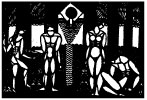Robert Allerton Parker, author of the second play on the third bill of the 1918-19 season, was born and reared in Alameda, California, which is directly east across the bay from San Francisco. Parker was a graduate in 1909 of the University of California at Berkeley before he came to New York City, where he lived most of the rest of his life. By 1914, he was an associate editor of Current Opinion, a popular literary journal published in New York City, with which he stayed until 1920.(1) He’d been very active in the Players’ first New York season, but seemed to drift off from them until this bill. The second play of the bill of four was 5050 by Parker, the title referring to the year in which it is set. It’s described by Kenton as the “first ‘Robot’ play ever staged,” and featured characters that were given numbers instead of names.(2) Though entirely written by Parker, he has fun by listing in the program that the play was “translated from the Tropismic,” referring to the fictional city where the plays take place three-thousand years in the future. The city is further described as “The Subterranean City of the Future” and the inhabitants of the city are divided between those who revere or despise the “Woodrovian Age,” a sly reference to Woodrow Wilson, US President in the age whose significance is being disputed (i.e. the present). In an archeological find, items from “the classical Manhattan era” are brought to Tropisma’s Municipal Museum; these items include the lions that sit in front of the New York Public Library and a potion sacred to the “twin gods, Haig and Haig” (referring satirically to the famous scotch). Those who admire the age revere most of all the ancient transportation system that they’ve deduced must have had as its primary purpose giving access to exhibits of contemporary art. Their archeological find, the audience soon realizes, is “the just excavated ‘art museum’. . . the advertisement-hung subway of the long lost city of New York.”(3) Those who despise the culture from 3,000 years earlier “are revolutionaries who advocate the cause of labor, free air for the general populace, and living in the Eternal Now.”(4) Other satirical cultural swipes include referring to the theatre of “the great Georgem” (as in George M. Cohan), “the sacred Shimmy” as a cultic dance of the time, and the consideration that the poetry of Ella Wheeler Wilcox was “classic.”(5)
Clearly, Parker was exploring the notion of what would happen if iconic items from popular culture of the time, including advertisements and sappy poetry, were all that remained of the artistic output of the era, thus satirizing this kind of “art” as well. Tidden in the Dramatic Mirror calls the play “a brilliant satire,” writing that Parker has “provided himself with a seed idea that could be made to grow into a thing of innumerable branches,” ultimately declaring that “the satire that springs from this is delicious.”(6) The reviewer from the Morning Telegraph is less generous, stating that the play’s “humor runs no deeper than ironic references of the classics of Dr. Fran Cane and Ella Wheeler Wilcox,” adding that “it is lightly gay when it isn’t angrily stepping in puddles.”(7) Broun in the Tribune simply writes that Parker “has allowed himself excellent material for satire.”(8)
One of the features of the play’s production, which was directed by Parker, seems to have been the futuristic costumes created for it. Kenton describes that Mabel Reber, her sister, “turned her Macdougal Street apartment into a dressmaking shop” and costumed the play, taking pasteboard boxes of all sizes and turning them into robot costumes for the five characters. Kenton describes the resulting costumes as being “squared or pyramidal with shooting decorative angles of more pasteboard.” Norma Millay, who played the character of 0369, remembers that “she wore a hat with a halo rigged at the end of a wire” and that the play “was a lot of fun to do.”(9) Kenton calls the play a “clever skit,” writes that a musical revue used the play as its source in the summer of 1919, and recalls that the costumes for the summer production were extravagant while the Players’ costumes cost between five and six dollars.(10) O.K. Liveright and Blanche Hays played the characters of 6699 and 0010 respectively in 5050.
© Jeff Kennedy, 2007.
(1) Sheaffer described Parker’s presence the night that Louis Hollady died of a heroin overdose on January 22, 1918. Parker later became a contributor to a number of journals and magazines, including Arts and Decoration, International Studio, Theatre Arts, often writing about visual art and modern aesthetics, and he was a drama critic for the weekly magazine Independent. He also wrote a number of biographies and books chronicling popular religious movements of his immediate past, including a biography of John Humphreys Noyes, founder of the Oneidia Community of Perfections. At the time of his death in 1970, he was reportedly working on a history of the theatre in America and had an unpublished novel of the American West based on the experiences of the Donner Party.
(3) Kenton 96.
(5) Wilcox was a poet whose work was extremely popular with the masses at the time, her work printed in over 250 newspapers, but is considered minor and ridiculous by most critics and modern writers. Her most quoted and famous line was from her poem “Solitude,” which actually is an adaptation of a line from Shakespeare: “Laugh and the world laughs with you, weep and you weep alone.”
(6) Dramatic Mirror, 8 February 1919, 197.
(7) Morning Telegraph, 20 January 1919.
(8) New York Tribune, 23 January 1919, col.4: 9.
(9) Sarlos, Jig 102.
